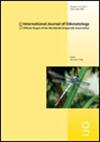Body temperatures in Sympecma paedisca (Zygoptera, Lestidae) in the autumn in the Central Ukraine
IF 1
4区 农林科学
Q3 ENTOMOLOGY
引用次数: 0
Abstract
This short communication reports on the warming ability of the damselfly Sympecma paedisca, which is known for its winter hibernation and tolerance to low temperatures. The data were collected using an infrared camera in late September on two sunny days (air temperature 15–17°C) in the vicinity of Kyiv, Central Ukraine. The obtained data show that the thorax was almost always the warmest part of the body (up to 21°C in comparison to 17–18°C of the substrates damselflies were resting on and surrounding living plants). This indicates that the animals, in addition to sun, use their thoracic musculature to warm their bodies up. There was a clear correlation between thorax temperature and the temperature of both the head and abdomen, which means the warmed up thorax can transport part of its heat to other parts of the body by using their circulatory system.乌克兰中部蝴蝶科昆虫的体温
这篇简短的通讯报道了豆娘的暖化能力,它以冬季冬眠和耐低温而闻名。数据于9月下旬在乌克兰中部基辅附近的两个晴天(气温15-17°C)使用红外摄像机收集。获得的数据表明,胸部几乎总是身体最温暖的部分(高达21°C,而豆娘所栖息的底物和周围的植物温度为17-18°C)。这表明,除了阳光,这些动物还利用它们的胸部肌肉组织来温暖身体。胸部温度与头部和腹部温度之间存在明显的相关性,这意味着升温的胸部可以通过循环系统将部分热量输送到身体的其他部位。
本文章由计算机程序翻译,如有差异,请以英文原文为准。
求助全文
约1分钟内获得全文
求助全文
来源期刊

International Journal of Odonatology
ENTOMOLOGY-
CiteScore
2.30
自引率
0.00%
发文量
15
审稿时长
>12 weeks
期刊介绍:
International Journal of Odonatology (IJO) is aimed at providing a publication outlet for the growing number of students of Odonata. It will address subjects such as the ecology, ethology, physiology, genetics, taxonomy, phylogeny and geographic distribution of species. Reviews will be by invitation, but authors who plan to write a review on a subject of interest to the journal are encouraged to contact the editor.
 求助内容:
求助内容: 应助结果提醒方式:
应助结果提醒方式:


